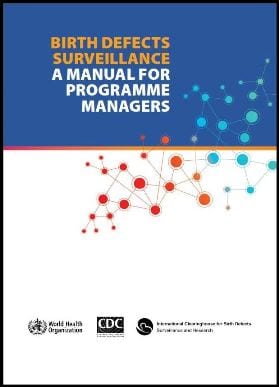Objectives of the Manual
Congenital anomalies, also known as birth defects, are structural or functional abnormalities, including metabolic disorders, which are present from birth. Congenital anomalies are a diverse group of disorders of prenatal origin, which can be caused by:
- single gene defects
- chromosomal disorders
- multifactorial inheritance
- environmental teratogens
- micronutrient malnutrition
This manual is intended to serve as a tool for the development, implementation and ongoing improvement of a congenital anomalies surveillance programme, particularly for countries with limited resources.
The focus of the manual is on population-based and hospital-based surveillance programmes. Some countries may not find it feasible to begin with the development of a population-based programme. Therefore, the manual covers the methodology needed for the development of both population-based and hospital-based surveillance programmes. Further, although many births in predominantly low- and middle-income countries occur outside of hospitals, some countries with limited resources may choose to start with a hospital-based surveillance programme and expand it later into one that is population based. Any country wishing to expand its current hospital-based programme into a population-based programme, or to begin the initial development of a population-based system, should find this manual helpful in reaching its goal.
This manual provides selected examples of congenital anomalies (see Appendix A). Typically, these anomalies are severe enough that they would probably be captured during the first few days following birth. Also, because of their severity and frequency, these selected conditions have significant public health impact, and for some there is a potential for primary prevention. Nevertheless, these are just suggestions, and countries can choose to monitor a subset of these conditions or add other congenital anomalies to meet their needs.
- describe the purpose and importance of public health surveillance of congenital anomalies;
- describe the use of logic models for planning and evaluation of a surveillance programme;
- understand how to present data to policy-makers;
- identify an initial list of congenital anomalies to consider for monitoring;
- describe the tools needed to ascertain and code identified cases;
- describe the processes for managing and analysing data;
- understand how to calculate the prevalence of congenital anomalies.
Surveillance of congenital anomalies should be ongoing and should involve a systematic review of birth outcomes to determine the presence of congenital anomalies. If countries have the capacity to identify risk factors associated with congenital anomalies such as maternal exposures (e.g., use of medications during the first trimester), a pregnancy registry or a case– control study can be implemented to allow for the collection of exposure data during pregnancy.
This manual is intended to facilitate the collection of essential information for the purpose of assessing the burden of congenital anomalies. It must be noted that the manual does not present specific information on how to collect risk factor information or how to manage a neonate born with congenital anomalies.
